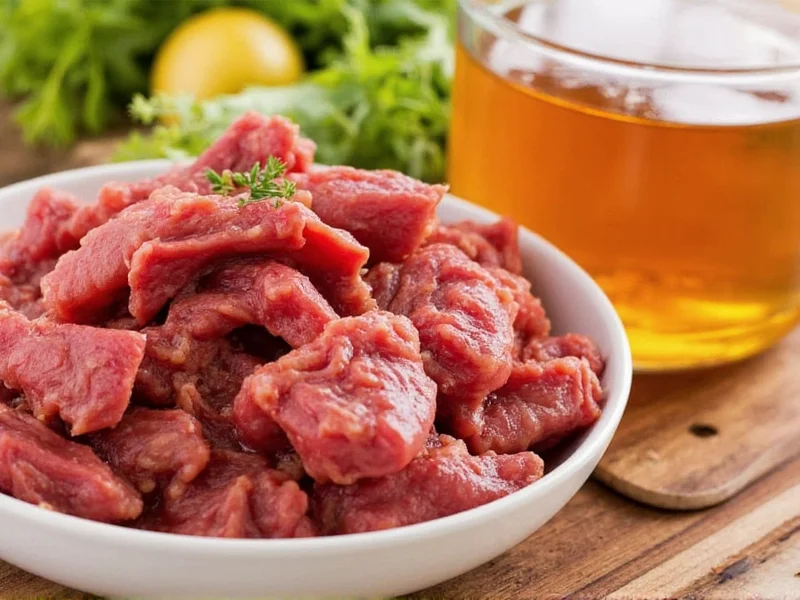Understanding the distinction between beef broth and beef stock matters for serious home cooks and culinary professionals alike. While many use these terms interchangeably in casual conversation, their preparation methods, ingredients, textures, and culinary applications differ significantly. Knowing when to reach for each can elevate your sauces, soups, and braises from good to exceptional. This definitive guide explores the technical differences, historical context, and practical applications of both foundational cooking liquids.
Defining Beef Stock: The Bone-Based Foundation
Beef stock represents one of the five mother sauces in French cuisine and serves as the backbone of countless professional kitchens. True beef stock begins with beef bones—typically marrow bones, knuckle bones, or oxtail—that undergo a meticulous preparation process:
- Roasting: Bones are roasted at 400°F (200°C) for 45-60 minutes to develop deep flavor through the Maillard reaction
- Simmering: Combined with aromatics and water, then simmered gently for 6-12 hours
- Extraction: Long cooking time dissolves collagen into gelatin, creating that signature mouth-coating texture
- Skimming: Impurities are carefully removed throughout the process for crystal-clear results
The extended cooking time extracts minerals and collagen from the bones, resulting in a liquid that solidifies when chilled due to its high gelatin content. This gelatin provides body to sauces and adds richness without overwhelming flavor.
Understanding Beef Broth: The Flavor-Focused Liquid
Beef broth takes a different approach, prioritizing immediate flavor over structural properties:
- Meat-forward: Contains substantial amounts of actual meat (often shank or chuck)
- Shorter cooking: Simmered for 2-4 hours to preserve bright, distinct flavors
- Ready-to-use: Designed to be consumed as-is, often seasoned for direct consumption
- Lighter texture: Contains less gelatin, remaining liquid even when chilled
Commercial beef broth typically includes salt and additional seasonings, making it suitable as a standalone soup base. The meat-to-bone ratio creates a more pronounced beef flavor that doesn't require reduction to shine.
| Characteristic | Beef Stock | Beef Broth |
|---|---|---|
| Primary Ingredients | Bones (80%),少量 meat, vegetables | Meat (60%), bones (20%), vegetables |
| Cooking Time | 6-12 hours | 2-4 hours |
| Gelatin Content | High (gels when chilled) | Low (remains liquid) |
| Salt Content | Unsalted (for versatility) | Seasoned (ready to consume) |
| Primary Use | Sauces, braises, soup base | Standalone soups, quick dishes |
Historical Context: How These Terms Evolved
The distinction between stock and broth has culinary roots stretching back centuries. In classical French cuisine, fond (foundation) referred specifically to bone-based liquids, while consommé described a clarified meat-based soup. The American culinary tradition later adopted and sometimes conflated these terms.
Food science explains the physical differences: bones contain connective tissues rich in collagen, which converts to gelatin during prolonged cooking. Meat provides myoglobin and other proteins that yield immediate flavor but less structural benefit. Understanding this biochemical distinction helps explain why professional chefs maintain separate preparation methods.
When Substitution Works (and When It Doesn't)
While many recipes use these terms interchangeably, certain applications demand specific properties:
Acceptable substitutions:
- Using broth in place of stock for quick pan sauces (though results will be thinner)
- Substituting stock for broth in soups that will simmer longer (dilute with water if too rich)
Avoid substitutions when:
- Making demi-glace or other reduction sauces requiring high gelatin content
- Creating aspic or dishes relying on stock's gelling properties
- Preparing consommé where clarity depends on proper stock preparation
For best results when substituting, adjust cooking times and liquid ratios. When using store-bought options for homemade stock, look for products labeled "bone broth" which typically have higher collagen content.
Homemade Preparation Guide
Creating authentic beef stock requires patience but yields superior results:
- Prepare bones: Roast 4 lbs beef bones at 400°F until deeply browned (45-60 min)
- Add aromatics: Transfer to stockpot with 1 chopped onion, 2 carrots, 2 celery stalks, 2 garlic cloves
- Cover with water: Add enough cold water to cover by 2 inches (about 4 quarts)
- Simmer gently: Maintain just below boiling point for 8-12 hours, skimming foam regularly
- Strain carefully: Use fine-mesh sieve, then cheesecloth for crystal-clear results
- Chill and defat: Refrigerate overnight to solidify fat for easy removal
For quick beef broth:
- Combine 2 lbs beef shank, 1 chopped onion, 2 carrots, 2 celery stalks in pot
- Cover with 8 cups water, bring to simmer
- Cook gently for 2-3 hours until meat is tender
- Season with salt, pepper, and herbs during last 30 minutes
- Strain and use immediately as soup base
Reading Store-Bought Labels Like a Pro
When purchasing commercial products, understanding labels prevents kitchen disasters:
- "Beef stock" typically indicates unsalted, bone-based product (check ingredients for bones)
- "Beef broth" usually means meat-based, seasoned for direct consumption
- "Bone broth" suggests extended cooking for higher gelatin content
- Avoid products with "natural flavors" or excessive sodium if using as sauce base
Professional chefs often use store-bought broth as a starting point, reducing it to concentrate flavor and adding gelatin powder to mimic stock's texture when needed.
Common Misconceptions Clarified
Several persistent myths confuse home cooks:
- Myth: Stock and broth differ only in salt content
Reality: While stock is typically unsalted, the fundamental difference lies in ingredients and cooking method - Myth: All bone broth is stock
Reality: Bone broth focuses on health benefits with extended cooking, while stock prioritizes culinary functionality - Myth: Stock must be gelatinous
Reality: Properly made stock gels when chilled, but many modern recipes use less bones for lighter results











 浙公网安备
33010002000092号
浙公网安备
33010002000092号 浙B2-20120091-4
浙B2-20120091-4